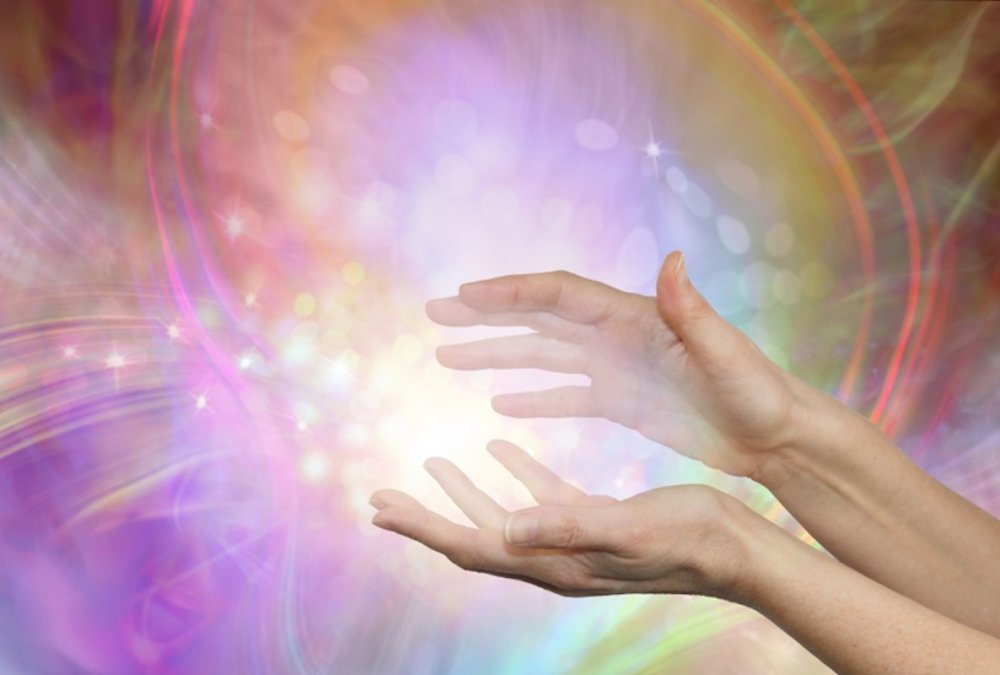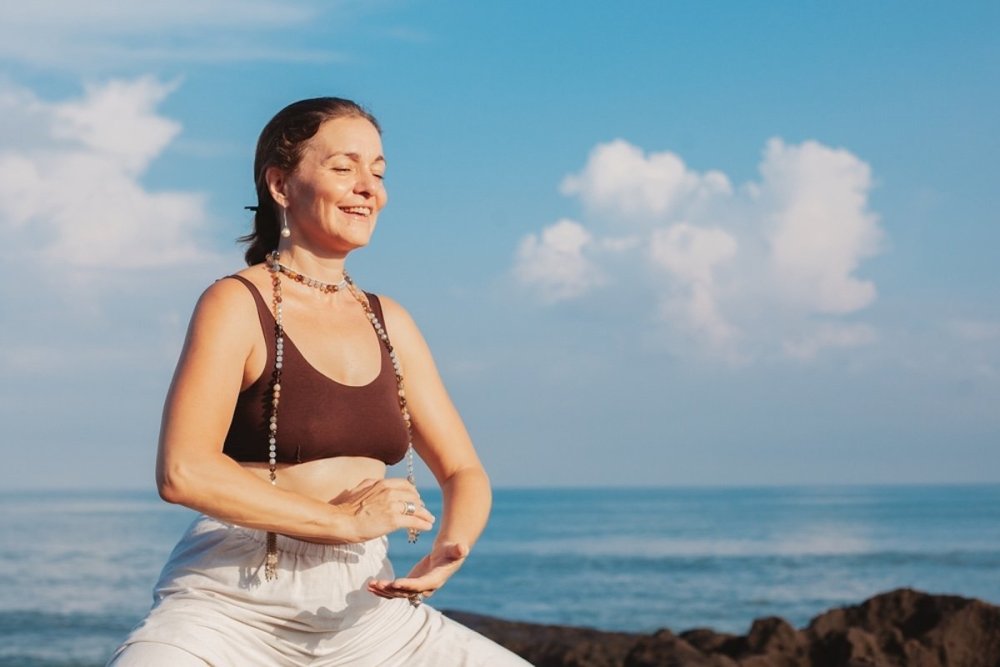Chi (qi) energy is our essential flow of life force energy. Rachel Markowitz explores the signs of imbalance and ways to restore chi balance through traditional techniques, including qigong, acupuncture, massage, and breathwork.
“Feel your chi between your hands and begin to shape it into a ball,” instructed a young, short, bubbly woman to a room full of skeptical students, including myself, who inadvertently ended up in her 'Intro to Tai Chi' workshop.
After self-consciously glancing around the room, I rubbed my hands together as shown to create heat and friction. With closed eyes, I guided my palms together and then apart, noticing a perceivable stretchiness or magnetism between them. Then, I imagined forming a ball – and, to my shock, felt a tangible sphere of energy between my hands.
Although I didn’t realize it at the time, this workshop served as a doorway – not only to learn about chi energy, but also to connect to the physical world in a way I had never experienced. More importantly, it gave me the confidence that we can all learn to sense chi. Let’s begin together by learning about the basics of chi energy and how to feel and balance this vital current.
What is Chi?
Chi, or qi, is the name given to an essential flow of life force energy that permeates our bodies and the world that surrounds us.
In the body, chi energy flows through channels called meridians. Each meridian line is related to certain aspects of ourselves. Thus, through various practices and habits to cultivate and balance chi, we can promote a healthy flow of energy and overall well-being.
RELATED:
- The Essentials of Energy Healing: 10 Techniques
- 5 Techniques to Balance Chakras and Unblock Energy Flows
- Exploring Shamanic Healing: What to Expect
The concept of chi is firmly rooted in Chinese culture and plays a major role in Traditional Chinese Medicine (TCM) and martial arts. However, the presence of an all-pervading energy linked to holistic well-being runs as a common thread through most ancient cultures.

Chi energy: our essential flow of life force
For example, the same energy that the Chinese call chi is known in yogic philosophy as prana and in Japanese as ki (as in Reiki). In ancient Egypt, it was known as ka; Polynesian culture calls this force mana, and some simply refer to it as Spirit.
Regardless of name, chi is the energy found in all of existence; it’s the age-old mysterious miracle that gives us breath and, therefore, life. By learning to feel and move chi, we cultivate a better connection to ourselves, others, and the universe.
The Benefits of Balancing Chi
Balancing chi energy can help with a variety of ailments in the body. However, we don’t need to wait until we’re sick to work towards a healthy flow of chi. Benefits of balanced chi energy include:
-
Physical Strength Working with chi helps us distribute our life force power in an efficient way and feel fully embodied. Balancing chi can remedy physical ailments and injuries by supporting the body’s immune system and natural healing abilities.
-
Mental Clarity When chi is blocked, we may feel mentally foggy or lethargic. Balanced chi manifests as a focused, attentive, and non-distracted mind.
-
Emotional Stability In Chinese medicine, emotional balance is connected to physical and mental health, as all are a reflection of balanced chi. Furthermore, medical research has found that chi-based movement practices can ease depression and anxiety, amongst other mood-enhancing benefits.
-
Connection to the Elements Chi is the invisible force that connects us to the natural world and our place within it. When chi is balanced, we feel comfortable in our surroundings.
- Connection to a Higher Power When we begin to feel and perceive chi, our awareness opens to a space beyond the physical body and the individual “I,” enhancing spiritual well-being.
Signs Your Chi is Out of Balance
Essentially, any physical, emotional, or recurring challenge in life could be attributed to unbalanced chi energy. According to TCM, chi manifests in various forms, and is closely associated with two opposite yet interconnected complementary forces – yin and yang. When yin – associated with femininity, darkness, and contraction, –is balanced with yang – associated with masculinity, lightness, and expansiveness – we experience harmony in life.
“Chi, or qi, is the name given to an essential flow of life force energy that permeates our bodies and the world that surrounds us.”
That being said, yin and yang are constantly fluctuating and changing in a dance of balance versus imbalance. Fortunately, our bodies and minds signal to us when something is not quite right. Signs that your chi energy may be out of balance include:
- Physical weakness or low stamina
- Allergies, a poor immune system, or the tendency to catch common colds and flus
- Poor digestion, IBS
- Emotional instability, insecurity, or self-doubt
- Disconnection from others or from nature
- An overall sense that something feels “off”
How Can I Balance My Chi? 5 Traditional Techniques
If you feel like you might be experiencing symptoms of unbalanced yin and yang, the following practices, based in TCM, work to regulate and manipulate the flow of chi energy, increasing health and vitality.
1. Qigong
Qigong (also written as chi gong) encompasses a variety of techniques intended to harness chi and distribute it throughout the body. Qigong practices incorporate movement, breath, and concentration. While some types of qigong focus on healing the physical body, others promote spiritual wholeness. Tai chi, another closely related body-mind practice, is a martial art that originates from Qigong.

Qigong is an ancient chi-balancing practice
2. Acupuncture
Acupuncture works by stimulating acupressure points that relate to different parts of the body, using thin needles. An acupuncturist will identify chi imbalances and release blockages or increase energetic flow to certain meridians or body parts through these points.
3. Breathing Techniques
Since our breath is our life force, we work directly with chi by controlling the breath. As previously mentioned, breathing is an integral part of a qigong practice.
“Balancing chi energy can help with a variety of ailments in the body. However, we don’t need to wait until we’re sick to work towards a healthy flow of chi.”
However, qigong breathing exercises on their own, or any other pranayama or conscious breathing techniques, can help to balance and regulate chi. If you’re new to intentional breathing, a good place to begin is with diaphragmatic breathing – slowly taking full, deep ”belly breaths,” with fixed length inhalations and exhalations.
4. Massage
Like a trained acupuncturist, a skilled massage therapist will be able to read your body, identify energetic patterns that might be causing imbalance, and help increase or redirect chi. TCM massage techniques include:
-
Tui Na: A traditional therapeutic massage that targets acupressure points in the body to improve circulation of blood and chi.
-
Cupping: Using cups to create a vacuum seal on the skin, increasing blood flow and detoxifying the body, moving blocked chi energy.
- Reflexology: Stimulating acupressure points, primarily in the feet, hands, and ears, that correspond to certain body organs or health systems

Cupping therapy is used to balance chi energy
5. Lifestyle Adjustments
Along with physical exercises, our eating habits, living environments (feng shui), and maintaining healthy sleep patterns contribute to balanced chi energy. Furthermore, TCM specialists often recommend herbal medicines to improve deficiencies or excesses of certain qualities in the body.
How to Balance Chi at Home
If you’re curious about understanding or balancing chi and are not inclined to see a specialist, the following practices you can do by yourself can help you connect.
-
Experiment with feeling your own energy. Take an introductory qigong or tai chi class, in person or online. Once you learn a few basic exercises, you can continue a daily practice on your own, cultivating a relationship with chi in your body and the environment.
-
Practice meditation. By committing a small amount of time each day to breathing intentionally while simply doing “nothing,” we relax the mind, calm the nervous system, and coax the body to come to a space of natural peace and balanced energy.
- Eat, sleep, and exercise regularly – with moderation. According to Daoism, an ancient system of Chinese spiritual and philosophical belief, the key to a healthy, balanced life is taking “the middle way.” Thus, if you’re inclined towards laziness or extreme intensity, keep in mind that even small, intentional changes in daily habits help us to cultivate chi flow and become aware of its presence.
Takeaway: What is Chi Energy?
Chi is the link between our internal and external environments, the microcosm and the macrocosm, and our worldly and spiritual experiences. When our chi energy is unbalanced, we often experience ailments or challenges. By learning how to balance chi through intentional practices, personal habits, and therapies, we can experience physical health, mental clarity, emotional stability, and the interconnectedness of all aspects of life. ●
Images: Sasha.shine.bright, Nikki Zalewski, Andrey_Popov
happiness.com | The fine art of being: learn, practise, share
Are you a happiness.com member? Sign up for free to enjoy:
■ our happiness magazine with practical life tips
■ sharing and supporting others in our happiness forum
Written by Rachel Markowitz
 Rachel recently found herself over a decade deep in a worldwide wander guided by what she feels to be true. She’s been facilitating classes and workshops on yoga, meditation, self-exploration, and alternative ways of living since 2012, mostly in Latin America and Asia. These days, she spends most of her time looking at, walking around, or singing to a sacred mountain in southern India. Read more of her words at her to those who wonder blog.
Rachel recently found herself over a decade deep in a worldwide wander guided by what she feels to be true. She’s been facilitating classes and workshops on yoga, meditation, self-exploration, and alternative ways of living since 2012, mostly in Latin America and Asia. These days, she spends most of her time looking at, walking around, or singing to a sacred mountain in southern India. Read more of her words at her to those who wonder blog.


Join the conversation
You are posting as a guest. If you have an account, sign in now to post with your account.
There are no comments to display.